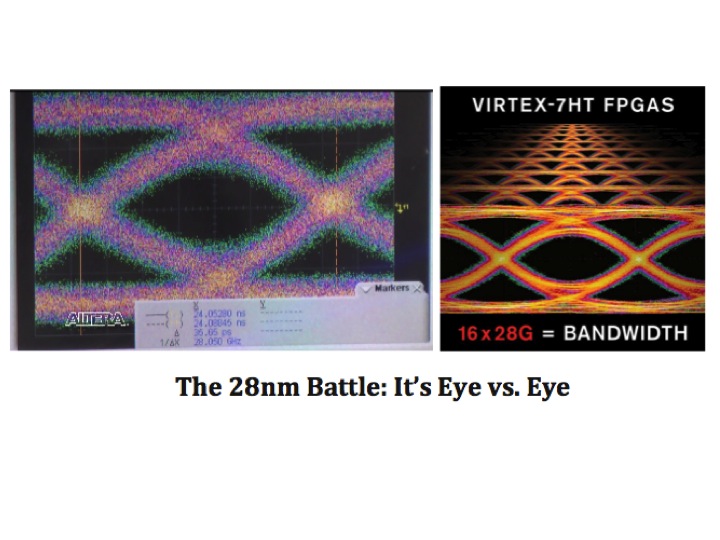28nm FPGAs are finally hitting the market and the next round in the battle between Altera and Xilinx is heating up. At 40nm, Altera beat Xilinx out the door by a year and as a consequence won a lot of new sockets in the high end Communications market. In the past year, Altera has closed the revenue and market share gap with Xilinx. This new round at 28nm looks to be much closer. However, the winner of the contest may come down to whom has the better eye – as in eye diagram.

Previously, I was a co-founder of Cswitch, a packet based FPGA startup that built the fastest FPGA in 90nm. It featured a new interconnect that could route 400Gb around the chip to be manipulated in special packet processing engines. It was an awesome chip that was suitable for 40G and 100G routers that would normally require 2 or 3 high end FPGAs. We were going after the 45% of the FPGA market tied to high $$$ wired and wireless communications. Alas we ran out of money after samples were delivered but before production started.
In the old days it was all about the tools – whoever has the best tools wins. More recently IP is playing a huge factor in who wins sockets as the engineers are looking to get their design done quickly and accurately. However, as you go up in performance and capability, it is the speed, number and quality of the Serdes that determines if you are even in the game to begin with. We were running 40 Serdes at 6.3G+ at Cswitch – today Xilinx and Altera are running up to 28G to support 100G/400G designs – Amazingly Fast. Altera and Xilinx want to get out of the gates quickly because they are first with the fastest Serdes (beating Broadcom and the NPU vendors). The prototype revenue alone is large as chips sell for $6K, $8K or $10K each. But Cisco, Alcatel, Huawei, Juniper, and others are looking to get product out quick with the latest 100G and 400G routers and switches to show their customers and perhaps do field trials.
Lately Xilinx and Altera are out promoting their Serdes heavily to convince engineers that they are ready.
Here’s Altera’s 28G Serdes Demo:
Here’s the Xilinx Serdes 28G Demo:
http://www.xilinx.com/technology/roadmap/28g-serial-transceiver-technology.htm
I am not an expert on Serdes but I am sure a few of our readers are and would be willing to share their thoughts on whether Xilinx and Altera have nailed it at 28nm. Who has the better eye and the least jitter? Let us know.
Share this post via:







Facing the Quantum Nature of EUV Lithography